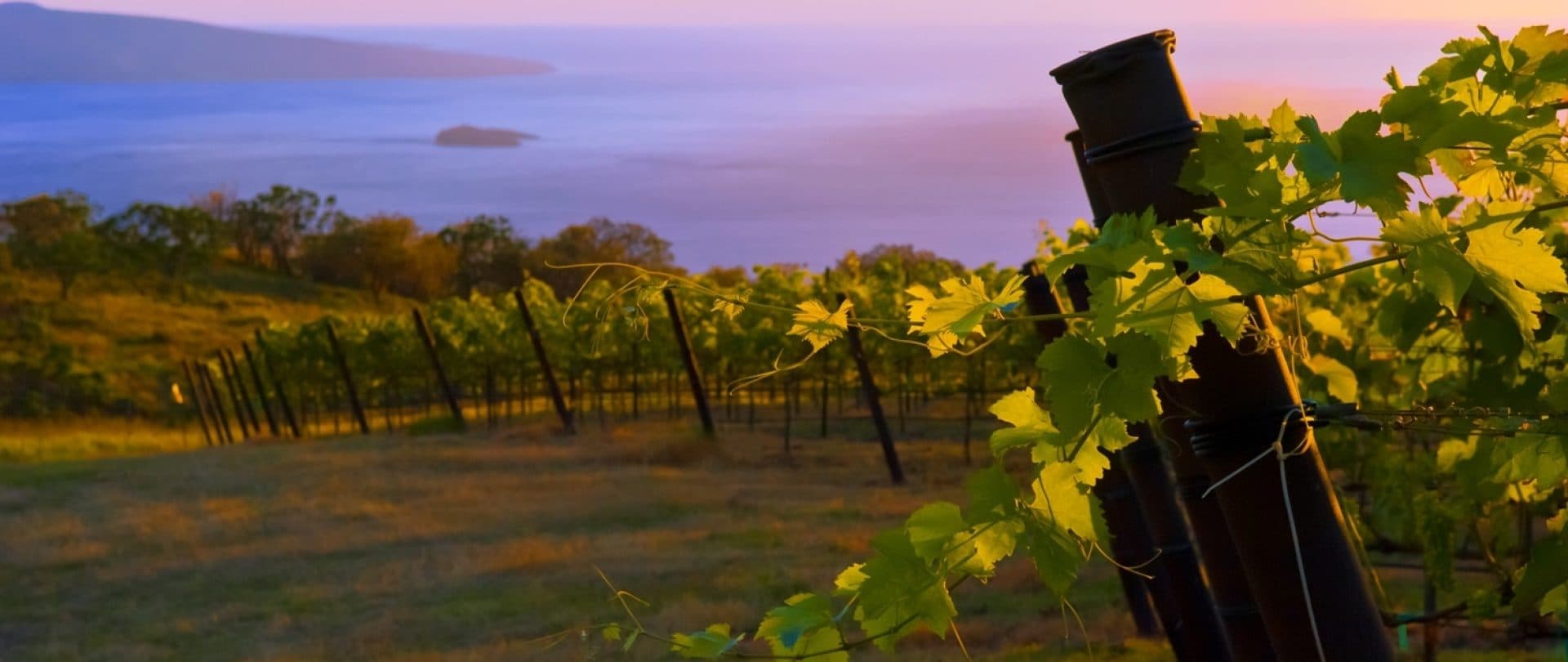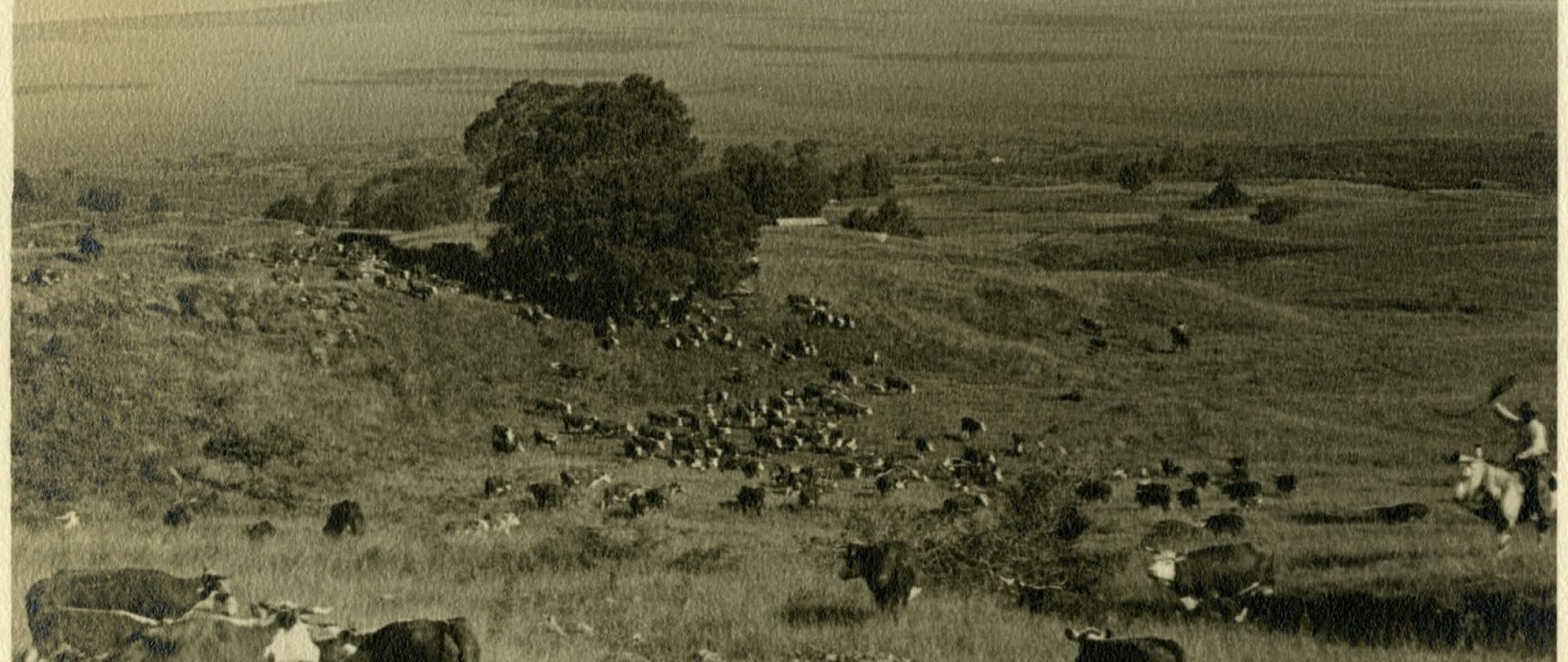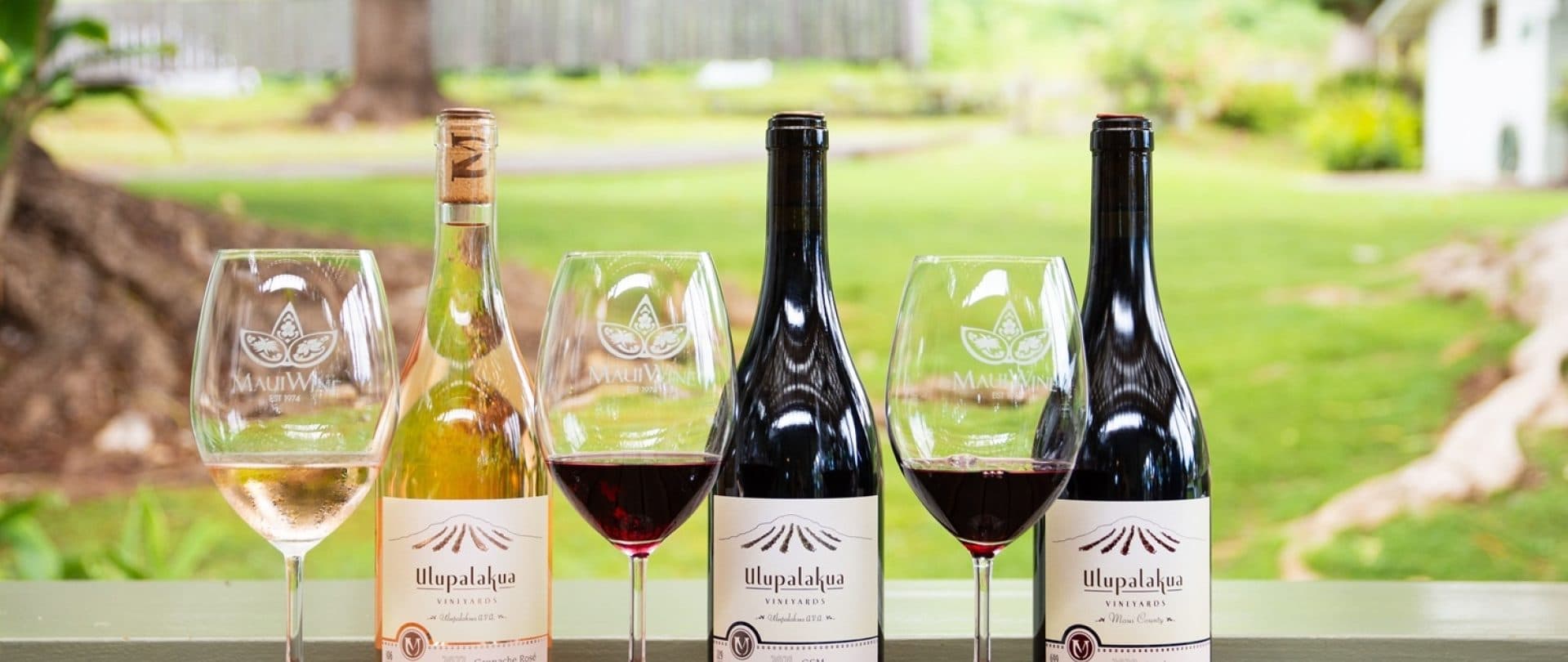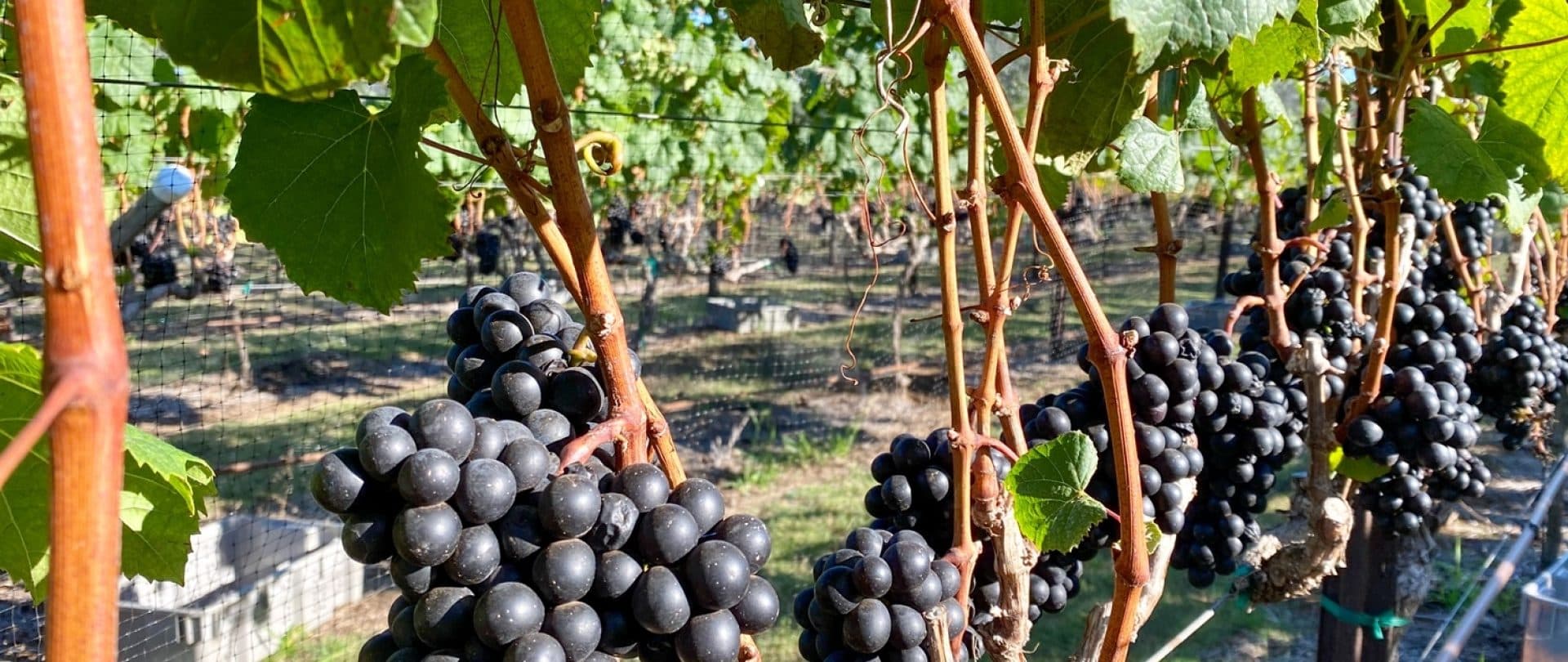Hawai‘i’s Wine Revolution
Maui's first AVA and the future of wines in the islands
BY Krystal Kakimoto
When people think of Hawaiian drinks, tropical cocktails and Kona coffee usually come to mind. But nestled between the volcanic slopes, Hawai‘i winemakers have been cultivating a wine scene that is as unexpected as it is impressive. With the recent establishment of the state’s first official American Viticultural Area (AVA), Hawai‘i wines’ reputation and pedigree have gained global recognition, marking a new era for wine in Hawai‘i.
The History of Wine in Hawai'i
The first record of wine grapes being grown in Hawai‘i dates to 1815 when a Spanish sailor, Francisco de Paula Marín, planted the first grape vines on the island of O‘ahu in the area surrounding Vineyard Boulevard, which was named in honor of his vines. Marín arrived in the islands in the 1790s and became an influential confidant and advisor to King Kamehameha I. A novice horticulturalist, Marín gathered a few grape cuttings during a trip to Santa Barbara and brought them back to the islands to see if they would grow. His first vines were flourishing, but wild hogs tore through the vineyard, and locals in the area grabbed bunches of grapes to eat as they walked through. Marín turned to his close friend, King Kamehameha I, to ask that a kapu be placed on the vineyard, making it forbidden for outsiders to take his grapes. Around 1820, records indicate that Marín’s vineyard was thriving, with two harvests per year and an annual wine production of approximately 1,300 gallons.
Most of the wine Marín produced was consumed by himself, foreign visitors, and members of the ali‘i (chiefly) class. Over time, the popularity of wine spread. Ships docking in Honolulu Harbor brought wine that they had collected during their voyages. Merchants advertised the different wines they carried in newspapers, and even King Kalākaua maintained a cellar in ‘Iolani Palace stocked with Premier Cru Bordeaux, Grand Cru Burgundy, and Rieslings from the Mosel region of Germany.
Despite the popularity of wine in the islands, the first commercial winery was not established until 1974 on the Ulupalakua Ranch in upcountry Maui. The area was leased originally by L. L. Torbert from King Kamehameha III in 1841, but, ever the seafarer, Torbert returned to sea after creating a small ranch. James Makee, a boat captain, was the next landowner when he bought Torbertsville in 1856, establishing Rose Ranch, named in honor of his wife, Catherine's favorite flower. For years, the family operated a sugar mill on the land, earning a reputation for hospitality and high yields. Captain Makee passed away in 1879, and the mill processed its final sugar crop in 1883. By 1922, it had become a cattle ranch.
The land passed hands and held different names until 1963, when C. Pardee Erdman purchased Ulupalakua Ranch. At that time, there were 6,000 heads of cattle worked by 30 ranch hands who lived on the ranch with their families. Erdman partnered with Emil Tedeschi, a vintner from California, to establish Maui’s first working winery in 1974. The duo repurposed the historic buildings on the property, including the old dairy, made of thick lava rock, which serves as the winery’s lab and bottling room, and the former jail, which has been converted into a private tasting room.
Carnelian, a black-skinned grape created in California by crossing Grenache with a Carignan-Cabernet Sauvignon hybrid, was planted in the 23-acre vineyard. While they waited for the vines to mature, they decided to practice their sparkling production with the cheapest fruit juice they could find, pineapple juice. This experimental wine was initially not intended for sale, but the public's response was so positive that the duo felt inclined to continue making pineapple wine. In 1977, they debuted their Maui Blanc pineapple wine, and by 1981, they were harvesting their first Carnelian grapes. As the decades went by, the winery became more established, launching its Maui Brut Blanc de Noirs in 1984, Maui Splash in 1992 and celebrating its twentieth anniversary in 1994 with the release of Hula o Maui, a pineapple sparkling wine made using the Traditional Method, or Methode Champenoise, which involves a second fermentation in bottles rather than tanks.
At the turn of the century, the team at Tedeschi Vineyards decided it was the right time to experiment with other grape varietals to see which ones would thrive in their location. In 2000, six acres of Syrah were planted, and the grape flourished. Originally from France, the long growing season and the ability to thrive in cooler climates, such as the Ulupalakua region, were two reasons the Syrah grape did so well. Following Syrah’s success, the team planted Viognier, Malbec, Grenache, Gewürztraminer, and Chenin Blanc, all of which have acclimated to the climate of upcountry Maui.
In 2015, the vineyard announced a rebrand as MauiWine. Today, a decade later, the company has earned the honor of being named Maui County’s Farm Family of the Year in 2021 under the helm of Paula Hegele, who joined the vineyard in 1990. MauiWine continues to preserve the culture of Ulupalakua under the winemaking vision that good wine is grown, not made.
Hawai‘i’s First AVA
As MauiWine solidified its reputation for creating stellar estate wines, a push was underway behind the scenes to petition for Ulupalakua to achieve its distinctive AVA status. An American Viticultural Area (AVA) is a way to distinguish grape-growing regions by identifying distinct qualities of that region’s climate and geographic features. Similar to regulatory systems in Europe, AVAs distinguish one wine-growing region from another, helping vintners more accurately describe the origin of their wine and enhance its reputation. For consumers, AVAs can help them better understand the quality, reputation, and characteristics of wine from specific AVAs, enabling them to make more informed purchasing decisions.
The first AVA in the United States was established in August 1980 with the creation of the Augusta AVA, which surrounds the town of Augusta, Missouri. As of October 2024, 276 AVAs are located across 34 states in the United States. In November 2020, paperwork was submitted petitioning the United States Tax and Trade Bureau to approve Ulupalakua as Hawai‘i’s first delimited AVA region. Integrating information on the region’s name, the area’s folklore, and specific deillegalscriptions of the area’s climate, soil, and unique aspects, the strong claim was approved. On June 30, 2021, the Ulupalakua AVA was established.
The Ulupalakua AVA measures approximately 70 acres, with about 16 acres under vines. The AVA lies in the “rain shadow” of Haleakalā, notable for its cloud cover and little rain. Sitting between 1,700 and 1,850 feet above sea level, the distinct nature of the region is a result of the prevailing trade winds, young volcanic soils, and subtropical, dry forest climate. The AVA soil predominantly comprises volcanic ash, with approximately 20% silt, loam, and clay. This combination of soil results in quick drainage, which causes the vines to stress and concentrate their flavors in the remaining grapes while still having enough structure and nutrients to support healthy vines. The temperature of the AVA ranges between 63°F and 88°F, and the leading varietals are Gewürztraminer, Chenin Blanc, Viognier, Grenache, Malbec, and Syrah. Within the AVA is one vineyard, Ulupalakua Vineyards, which MauiWine owns, and whose grapes are sent to the winery just a few miles away for processing.
MauiWine
For the team at MauiWine, adjustments have been made to accommodate Hawai‘i’s climate, which is vastly different from most wine-growing regions in the world. “Maui’s unique climate and geography require a shift in traditional viticultural timelines,” says Henry Hegele, winemaker at MauiWine. "Unlike mainland vineyards, where winter dormancy dictates pruning schedules, we begin pruning mid-winter, allowing us to harvest throughout the summer. This timing helps balance the vines’ natural growth cycles while avoiding the peak of hurricane season in September and October.”
Annual production ranges from 12,500 to 20,000 cases, depending on the vintage conditions. This variation reflects the team at MauiWine's respect for the vines themselves. Hegele notes, “The variations in yield reflect our commitment to quality-driven viticulture, where each vintage is shaped by the island’s unique growing season.”
The hallmark of their brand has become their sparkling wines, all of which are created in the Traditional Method. From their sparkling brut pineapple wine, Hula o Maui, to their refreshing sparkling brut rosé, Lokelani, the celebratory nature and bright flavors of their sparkling wines are easily enjoyed with local cuisines or sipped on a warm afternoon. Beyond their sparkling wines, their Estate reds, especially Syrah and Malbec, are highly sought after. The rustic, complex Syrah and elegant Malbec are two wines that pair well with a variety of foods. MauiWine’s winemaking approach for red wines includes moderate and light oaking to avoid overbearing finished wines. For grapes deemed the “cream of the crop,” they will see some time aging in neutral oak barrels. For non-barrel aging, oak staves are added to the aging to impart oak elements to the wine gently.
MauiWine welcomes guests to their property to share in the learning, discovery, and celebration of their wines. At the King’s Cottage Tasting Room, you can relax on the lānai and sip wine while immersing yourself in the history of the estate. The cottage was constructed in the 1870s to accommodate King Kalākaua during his visits to the ranch. The King’s Cottage Tasting is open from 11 a.m. to 5 p.m., Tuesday through Sunday. During this time, guests are invited to enjoy tasting flights, wine by the glass, wine cocktails, and light food fare independently, creating a truly personalized experience.
For those wanting a more guided experience, there is the Tasting Table, where guests sit at a communal table of eight in the Old Stone Office, one of the historic buildings on the property dating to the 1860s. The tasting is led by a knowledgeable MauiWine ambassador who discusses the varietals cultivated in the vineyards, MauiWine’s winemaking style, and the process of creating the wines. This 90-minute experience is offered on Thursdays at 11 a.m.
For a semi-private, scenic experience, the Tasting the Gardens option allows guests to experience a two-hour seated tasting beneath the trees, which have stood for over 150 years and are surrounded by the remnants of Catherine Makee’s garden. This tasting features a toast upon arrival, a custom tasting flight, an extensive gourmet grazing board, and a pour of the Lehua Dessert Wine paired with Hawai‘i chocolate.
Hegele reflects on over fifty years of winegrowing in the region, saying, “Ulupalakua AVA represents a journey of trials and experimentation. This AVA acknowledgment opens a new door for creativity in an industry often defined by tradition and legacy,” said Hegele. He observes the increasing interest in white Rhône varietals such as Roussanne, Marsanne, and Grenache Blanc. “These grapes could add another dimension to our white wine program, offering new blending opportunities and fresh expressions of the vineyard.”
Hawai‘i’s wine industry is in the midst of an exciting revolution, blending deep-rooted history with modern innovation. With the recent establishment of the Ulupalakua AVA and MauiWine’s growing influence on the global stage, the islands are proving that exceptional wines can thrive in unexpected places. As winemakers continue to push boundaries and experiment with terroirs and varietals, Hawai‘i’s reputation in the wine world is poised to grow. The future is bright for Hawaiian wine, offering a taste of the islands that is bold, diverse, and as unforgettable as the land itself.
MauiWine, 14815 Pi‘ilani Hwy. Kula; (808) 878-6058; mauiwine.com; Open Tuesday through Sunday, 11 a.m. to 5 p.m.




